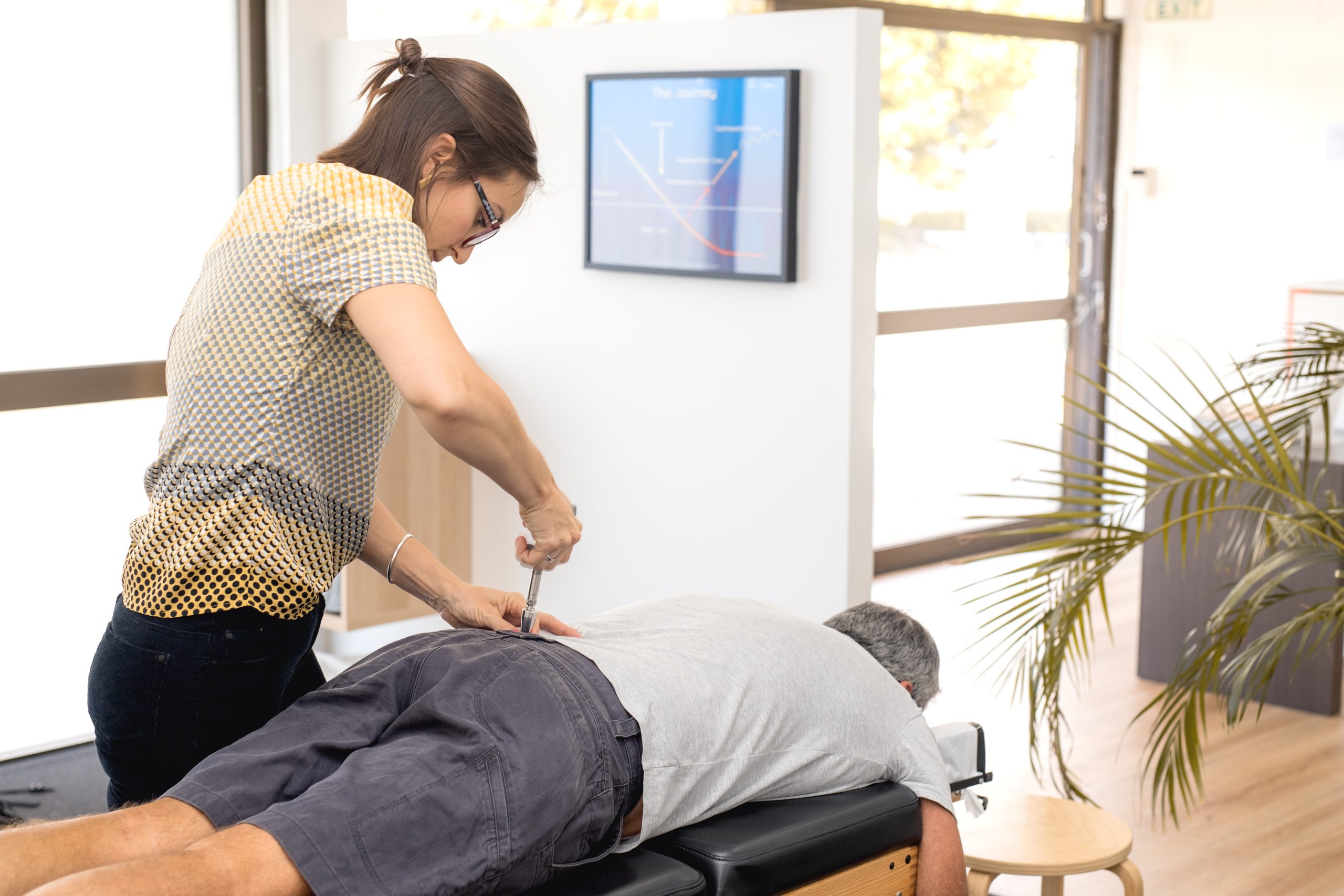Back pain isn’t just a nuisance, it’s one of the leading causes of disability worldwide, affecting millions of people from all walks of life. From office workers sitting at desks for hours to athletes, manual laborers, and even retirees, back pain can disrupt everyday routines, limit mobility, and significantly reduce quality of life. And for those suffering from herniated discs, sciatica, spinal stenosis, or nerve compression tied to neuropathy, the pain can be constant and excruciating.
Unfortunately, many patients are left with only a few traditional options: take painkillers, undergo invasive surgery, or simply “learn to live with it.” But what if there was another path, one that targets the root of the problem instead of just masking the symptoms? That’s where spinal decompression comes in.
Spinal decompression is a proven therapeutic approach designed to relieve pressure on the spinal discs and nerves. It helps create space within the spine, allowing damaged discs to reposition and heal, nerves to decompress, and inflammation to subside. Whether delivered through advanced non-surgical techniques or through carefully considered surgical procedures, spinal decompression has helped countless patients reclaim their lives from chronic pain.
This guide is designed to give you a clear, comprehensive understanding of what spinal decompression is, how it works, and whether it might be right for you. You’ll learn about both non-surgical and surgical options, what to expect during treatment, the benefits for individuals suffering from neuropathy, and how this therapy compares to other solutions for back pain relief.
If you’re feeling stuck, frustrated, or unsure about your options, you’re not alone, and you’re not without hope. Relief may be closer than you think.
What Is Spinal Decompression?
Spinal decompression is a targeted therapeutic approach used to relieve pressure on the spine’s discs, joints, and nerves. This pressure often results from common spinal conditions such as herniated discs, bulging discs, degenerative disc disease, or spinal stenosis. Left unaddressed, these conditions can lead to chronic back or neck pain, numbness, muscle weakness, or nerve-related issues such as sciatica and neuropathy. Spinal decompression is designed to treat the root cause, not just the symptoms, by relieving the physical compression at the source.
There are two main forms of spinal decompression: non-surgical and surgical. Non-surgical decompression uses a motorized table or spinal decompression machine to gently stretch and relax the spine in cycles. This reduces pressure within the spinal discs, encourages retraction of bulging material, and enhances the flow of oxygen and nutrients to promote healing.
In contrast, surgical spinal decompression involves physical alterations to the spine, such as removing part of a vertebra or disc, to relieve nerve impingement. Surgery is typically reserved for severe or non-responsive cases.
Whether used alone or alongside other therapies, spinal decompression offers a proactive path to restoring spinal health, improving mobility, and reducing chronic pain, especially in those suffering from long-standing back issues or nerve compression.
How Spinal Decompression Works
Non-surgical spinal decompression therapy works by applying controlled, computer-guided traction to the spine using a specialized decompression table. During treatment, the patient lies comfortably on the table while a harness is gently secured around the hips or upper body, depending on the area being treated. The machine then creates rhythmic cycles of stretching and relaxation that carefully elongate the spine without triggering muscle guarding or spasms.
This gentle traction produces negative intradiscal pressure, a vacuum-like effect inside the spinal discs. As a result, herniated or bulging disc material can retract back into its proper position, relieving pressure on nearby nerves. This decompression not only eases pain and inflammation but also enhances the flow of oxygen, water, and nutrient-rich fluids into the disc space, elements critical for tissue repair and regeneration.
Over time, this improved environment helps promote natural healing, reduce nerve compression, and restore better spinal alignment. Unlike traditional traction methods, spinal decompression therapy is customized in real-time to the patient’s needs, ensuring both safety and comfort.
For many people suffering from disc-related conditions or nerve compression, spinal decompression offers a non-invasive, drug-free alternative that targets the underlying cause of pain rather than just managing symptoms.
Non-Surgical Spinal Decompression Therapy
The Process Explained
Non-surgical spinal decompression is a modern, non-invasive therapy designed to gently relieve pressure on the spine and support natural healing. The treatment is performed on a specially designed traction table, also known as a spinal decompression machine. During each session, the patient lies down comfortably, face up or face down depending on the condition, and is fitted with a harness around the pelvis and sometimes the upper torso.
Once secured, the machine carefully calibrates a series of pulling and relaxing cycles that stretch the spine in a highly controlled manner. This rhythmic traction gradually reduces pressure on the spinal discs and nerves. Each session typically lasts 20 to 45 minutes, and most treatment plans include 15 to 30 sessions over a 4- to 6-week period.
Unlike traditional traction, this therapy adjusts in real-time to prevent muscle resistance, ensuring a gentle and effective stretch. Many patients find the sessions relaxing, some even report falling asleep during treatment.
Common Conditions Treated:
Spinal decompression is effective for a range of disc- and nerve-related conditions, including:
- Herniated or bulging discs – Helps retract disc material and ease nerve irritation
- Sciatica – Relieves pressure on the sciatic nerve to reduce leg pain
- Degenerative disc disease – Improves disc hydration and reduces inflammation
- Facet syndrome – Helps reduce stress on small stabilizing joints in the spine
- Spinal stenosis – Opens up space within the spinal canal for nerve function
Peripheral neuropathy caused by nerve compression – Reduces nerve impingement contributing to numbness, tingling, and weakness
Benefits of Spinal Decompression
Patients often turn to spinal decompression as a safe, drug-free alternative to surgery. The benefits include:
- Back pain relief without medication or surgery – Ideal for those seeking non-invasive solutions
- Improved spinal alignment – Restores posture and balance in the spine
- Reduction of nerve compression – Alleviates shooting pains, numbness, and tingling
- Encourages disc rehydration and healing – Promotes long-term spinal health
- Relief from neuropathy symptoms – Especially helpful for patients with compression-related nerve damage
Spinal Decompression for Neuropathy
What Is Neuropathy?
Peripheral neuropathy is a condition that results from damage to the peripheral nerves, those located outside the brain and spinal cord. These nerves play a vital role in transmitting signals between your central nervous system and the rest of your body, including your arms, legs, and internal organs. When these nerves become damaged or compressed, the communication between the brain and the body is disrupted, leading to a wide range of symptoms.
Common signs of neuropathy include:
- Tingling or “pins and needles” sensations
- Burning pain
- Muscle weakness
- Numbness or loss of sensation
- Heightened sensitivity to touch
- Loss of coordination or balance
Neuropathy can be caused by a variety of factors, including diabetes, infections, autoimmune diseases, and physical trauma. In many cases, however, nerve compression within the spine, due to herniated discs, spinal stenosis, or degenerative disc disease, can be a direct cause. When spinal nerves are pinched or inflamed, it can lead to radiating nerve pain and dysfunction, especially in the legs or arms.
How Decompression Helps Neuropathy Patients
Spinal decompression therapy offers a promising, non-invasive approach to addressing nerve compression that contributes to neuropathy symptoms. By gently stretching the spine using a motorized traction system, spinal decompression helps create negative pressure within the spinal column. This negative pressure allows bulging or herniated discs to retract, relieving pressure on the nearby nerve roots.
As the pressure is alleviated, blood flow and oxygenation to the affected area improve, which is critical for nerve healing and function. This increase in circulation reduces inflammation, delivers essential nutrients, and promotes the body’s natural repair processes.
For patients whose neuropathy stems from spinal issues, decompression therapy can provide relief from:
- Burning or shooting nerve pain
- Tingling and numbness in extremities
- Muscle weakness and coordination issues
- Decreased mobility or balance
Unlike medications that mask symptoms, spinal decompression targets the underlying mechanical cause of nerve irritation. As the spinal environment becomes more stable and less compressed, patients often notice a significant reduction in their neuropathy symptoms, sometimes within just a few weeks of consistent treatment.
Surgical Spinal Decompression Options
While many patients experience significant relief through non-surgical spinal decompression, surgical intervention may be necessary when conservative treatments fail or when structural damage to the spine is too severe. Surgical spinal decompression is designed to directly relieve pressure on the spinal cord or nerve roots caused by conditions such as herniated discs, spinal stenosis, bone spurs, or degenerative changes in the spine.
When Is Surgery Recommended?
Surgical decompression may be considered if:
- Non-surgical decompression provides limited or temporary relief
- There’s loss of bladder or bowel control (cauda equina syndrome)
- Muscle weakness or numbness is rapidly worsening
- Imaging reveals severe spinal narrowing or disc extrusion
- A patient has spinal instability requiring structural correction
Common Surgical Techniques
Each procedure is chosen based on the location and cause of nerve compression:
- Laminectomy – Removes part of the vertebral bone (the lamina) to widen the spinal canal and relieve pressure on the spinal cord or nerves. Often used for spinal stenosis.
- Discectomy – Involves removing the damaged portion of a herniated disc that is pressing on a nerve. This is commonly used for disc-related sciatica or radiculopathy.
- Foraminotomy – Enlarges the neural foramen, the small openings where nerves exit the spinal canal. This procedure is often used when nerves are compressed at these exit points.
- Spinal Fusion – Stabilizes the spine by permanently joining two or more vertebrae. This may follow other procedures (e.g., after discectomy or laminectomy) to prevent further instability.
Risks and Recovery
While surgical spinal decompression can offer lasting relief, it comes with inherent risks and longer recovery times compared to non-invasive options. Potential risks include:
- Infection
- Blood clots or bleeding
- Nerve damage or spinal fluid leaks
- Reaction to anesthesia
- Failed back surgery syndrome (continued or worsened pain)
Recovery time varies by procedure and individual health status but typically ranges from 6 weeks to 6 months. Physical therapy and lifestyle modifications are often required to regain strength and mobility.
Despite these challenges, surgical decompression can be highly effective, particularly for patients with structural damage, spinal instability, or progressive neurological symptoms.
Who Is a Candidate for Spinal Decompression Therapy?
You may be a candidate if you have:
- Chronic back or neck pain
- Sciatica or radiating leg pain
- Herniated or bulging discs
- Numbness, tingling, or weakness in limbs
- Neuropathy due to nerve root compression
Who Should Avoid It?
Spinal decompression may not be suitable for:
- Pregnant individuals
- Patients with spinal tumors or fractures
- Severe osteoporosis
- Previous spinal fusion patients
What to Expect During a Spinal Decompression Session
Spinal decompression therapy is a comfortable and non-invasive treatment designed to relieve pressure on your spine and promote healing. It’s typically performed in a clinical setting under the supervision of a trained provider, such as a chiropractor, physical therapist, or pain specialist. Sessions usually last between 20 and 45 minutes, and most patients undergo a treatment plan of 15 to 30 sessions spread over 4 to 6 weeks, depending on their condition and response.
During Treatment
When you arrive for your session, you’ll be guided to a specialized decompression table. You’ll lie either on your back or stomach, depending on the target area of your spine.
Here’s what a typical session includes:
- Harness Application: A padded harness is gently secured around your hips (and sometimes your upper body) to help deliver traction to your spine.
- Gentle Stretching: The machine uses computer-guided technology to create controlled, rhythmic pulling and releasing cycles that gradually stretch and relax your spine.
- Real-Time Adjustments: The system monitors resistance and adjusts accordingly, ensuring comfort and effectiveness throughout the session.
- Relaxation: Many patients describe the sensation as soothing or similar to a gentle massage—some even fall asleep during treatment.
After Treatment
Following each session, patients may experience:
- Immediate Relief: Some feel pressure or pain right away.
- Gradual Improvement: Others notice changes more slowly over the course of multiple sessions.
- Mild soreness: Similar to post-exercise stiffness, this is often a sign that the spine is adjusting to its new alignment.
Combining Spinal Decompression with Other Therapies
For optimal results, spinal decompression is often part of a multi-modal treatment plan. Combining it with complementary therapies can enhance healing, reduce inflammation, and accelerate recovery.
Commonly Paired Therapies:
- Chiropractic Adjustments: Improve spinal alignment and nerve communication.
- Physical Therapy: Builds core strength, flexibility, and postural awareness to support spinal health.
- Neuropathy-Specific Treatments: Such as infrared light therapy, nutritional support, or nerve stimulation for those with nerve damage symptoms.
- Massage Therapy: Reduces muscle tension, improves circulation, and enhances relaxation post-treatment.
- Postural & Rehabilitative Exercises: Focus on correcting biomechanics, preventing recurrence, and maintaining spinal stability.
Frequently Asked Questions (FAQ)
What is spinal decompression therapy?
Spinal decompression therapy is a non-invasive, FDA-cleared treatment that uses a motorized traction table to gently stretch the spine. This process reduces pressure on spinal discs and nerves, helping to relieve conditions such as herniated discs, sciatica, and degenerative disc disease. The gentle stretching creates negative pressure within the spinal discs, which can retract bulging material and improve the flow of nutrients, oxygen, and water to the area, supporting natural healing and pain relief.
How long does it take to see results?
While results vary from patient to patient, many individuals begin to notice improvement within the first few sessions. Most treatment plans include 15 to 30 sessions over 4 to 6 weeks. For chronic or severe conditions, full benefits may be realized closer to the end of the treatment cycle. As the spine decompresses and healing occurs, symptoms like pain, tingling, or weakness typically become less frequent and intense.
Is spinal decompression safe?
Yes, non-surgical spinal decompression is considered a safe and well-tolerated treatment when performed by trained professionals. The equipment is computer-controlled and adjusts in real time to ensure gentle, customized traction based on your body’s needs. It is an ideal alternative for patients looking to avoid the risks associated with surgery or long-term medication use. However, it may not be recommended for individuals with severe osteoporosis, spinal fractures, or previous spinal fusion surgery.
Can spinal decompression help with neuropathy?
Absolutely. If your neuropathy is caused by spinal nerve compression, spinal decompression can provide significant relief. By relieving the pressure on affected nerves, the therapy helps reduce symptoms such as burning pain, tingling, numbness, and muscle weakness. As blood flow and nerve function improve, many patients experience better mobility and reduced discomfort, often within a few weeks of starting treatment.
Does spinal decompression hurt?
Most people experience a gentle stretch and even relaxation during the session. Some may feel mild soreness afterward, similar to a light workout.
Key Takeaways
- Spinal decompression can be a powerful, non-invasive tool for back pain relief and neuropathy improvement.
- It’s a safe, effective alternative to surgery for many people.
- Whether you’re suffering from herniated discs, sciatica, or nerve-related discomfort, decompression therapy can offer measurable relief.
Conclusion: Reclaim Your Life from Pain
Living with chronic back pain or neuropathy doesn’t have to be your new normal. Spinal decompression therapy, whether non-surgical or surgical, offers a science-backed, patient-focused solution that targets the root cause of discomfort rather than just masking symptoms. From gentle, computer-controlled stretching sessions to advanced surgical techniques when needed, spinal decompression creates the space your spine and nerves need to heal, restore function, and relieve pain. Whether you’re struggling with herniated discs, sciatica, degenerative disc disease, or nerve compression linked to neuropathy, there’s a path forward, and it doesn’t have to involve endless medications or invasive procedures. With the right treatment plan and professional guidance, you can take back control of your mobility, comfort, and quality of life. If you’re ready to explore a safer, smarter way to find long-lasting relief, spinal decompression may be the breakthrough you’ve been searching for.




